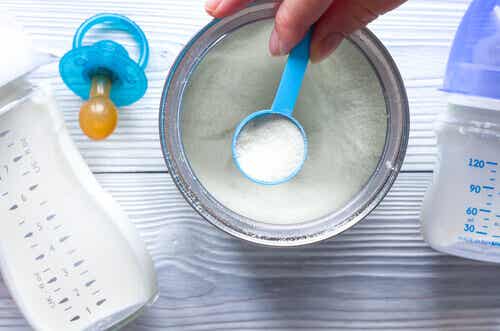What Is Hydrolyzed Milk?


Written and verified by the nutritionist Saúl Sánchez Arias
Hydrolyzed milk is a product made for infants that are allergic to cow’s milk protein. It contains the protein compounds broken into very small fragments for easy absorption. In turn, this reduces their capacity to produce an allergic reaction.
When is hydrolyzed milk used?
Like any formula milk, hydrolyzed milk is used when breastfeeding isn’t an option. Before the baby turns 6 months old, they should be fed exclusively on milk. If the mother’s milk isn’t available, the child’s parents must resort to formulas that imitate its composition.
Although the industry has come a long way in this respect, there are significant differences between feeding a baby with breast milk or with a formula product. The main alterations occur at the microbiota level, according to an article published in the journal Frontiers in Immunology.
Resorting to commercial products may increase the risk of the child suffering from autoimmunity-related problems later in life. However, as we said, in some cases the baby is allergic or intolerant to cow’s milk proteins. In these cases, hydrolyzed milk is the only answer.
Fortunately, this product often comes enriched with micronutrients to promote the baby’s development. One example is omega-3 acids, which contribute to proper cognitive development, according to a study published in 2018.

There’s nothing like breast milk
Despite the wide range of products on the market for feeding newborns, breastfeeding is always the best option. It has positive nutritional and bonding properties for mother and child.
If, for some reason, the mother can’t breastfeed her child, one option is to use a milk bank. It’s a very effective option when it comes to providing top-quality nutrition, at least for the first 6 months.
You may like: Breast Milk Donation: Everything You Need to Know
Complementary feeding
When the baby turns 6 months old, you can abandon breastfeeding or formula milk as the exclusive feeding method. At this time, you can start introducing solid foods. This way, the aim is for the baby to adapt to the environment and explore new textures and flavors.
Experts recommend the method known as baby-led weaning, whereby the baby is allowed, with some supervision, to consume food on their own. This feeding pattern doesn’t lead to an improvement in health, but it does lead to a better adaptation in terms of feeding.
It’s positive to apply proper dietary habits from the earliest stages of life. This reduces the number of food refusals in adulthood, which is a step towards a varied and balanced diet.
Additionally, we should bear in mind that the baby’s diet in the early stages of life conditions its microbiota. This may have implications on the risk of developing diseases in the medium and long term.

Keep reading: Should You Wake Your Baby for Feedings?
Hydrolyzed milk, an alternative to breast milk
Hydrolyzed milk is an effective alternative for infants with cow protein allergy. However, not all infants should consume it since the intake of a hydrolyzed product in the early stages can interfere with the production of digestive enzymes.
This leads to the appearance of intolerances in the medium term, which can be a problem in terms of feeding. In addition, we must bear in mind that breastfeeding is always the preferred option.
Breast milk contains all the nutrients the baby needs in optimal proportions. It guarantees a correct development of the microbiota and a reduced risk of autoimmune diseases.
Lastly, when the baby is 6 months old, you should start introducing solid foods in the infant’s diet. This encourages the baby’s participation in feeding habits.
This practice helps them adapt to different textures and flavors, and reduces the risk of rejecting food at a later stage. However, an adult should always supervise this process!
All cited sources were thoroughly reviewed by our team to ensure their quality, reliability, currency, and validity. The bibliography of this article was considered reliable and of academic or scientific accuracy.
- Doare KL., Holder B., Bassett A., Pannaraj PS., Mother’s milk: a purposeful contribution to the development of the infant microbiota and immunity. Front Immunol, 2018.
- Shulkin M., Pimpin L., Bellinger D., Kranz S., et al., N-3 fatty acid supplementation in mothers, preterm infants, and term infants and childhood psychomotor and visual developmetn: a systematic review and meta analysis. J Nutr, 2018.
- D’Auria E, Bergamini M, Staiano A, et al. Baby-led weaning: what a systematic review of the literature adds on. Ital J Pediatr. 2018;44(1):49. Published 2018 May 3. doi:10.1186/s13052-018-0487-8
This text is provided for informational purposes only and does not replace consultation with a professional. If in doubt, consult your specialist.








